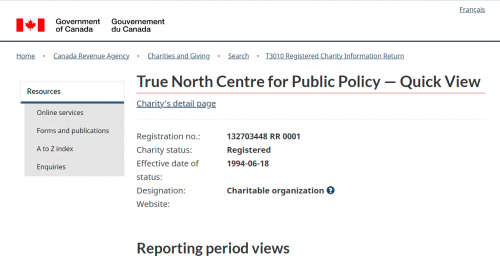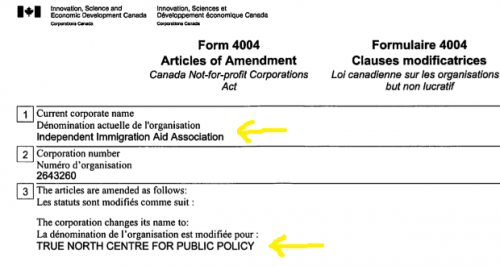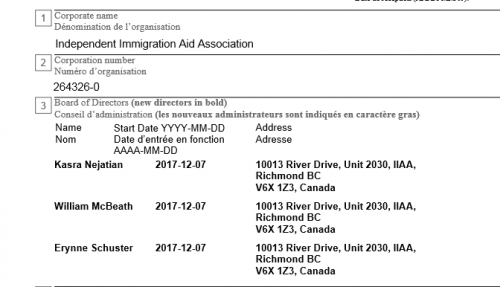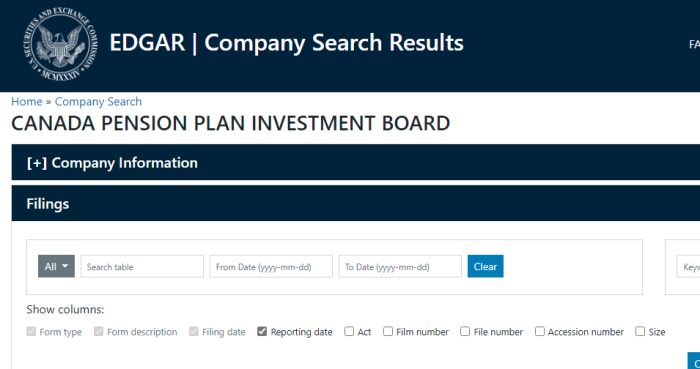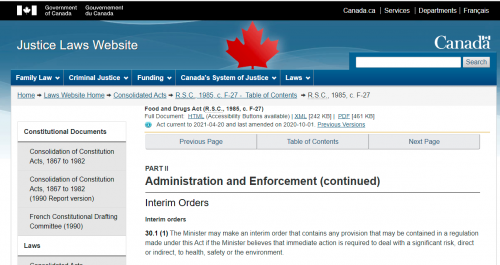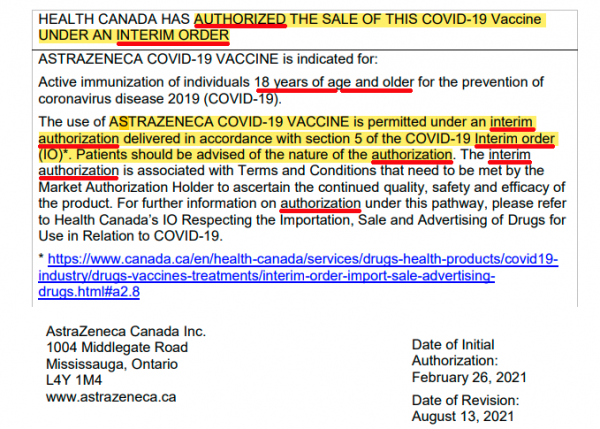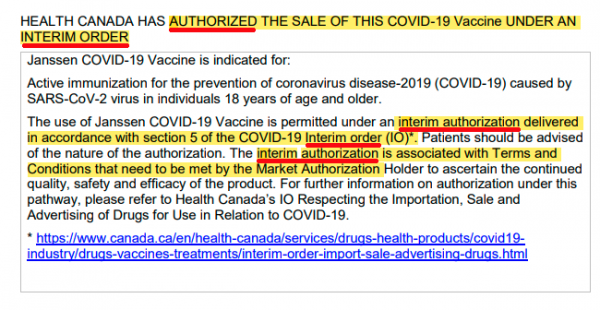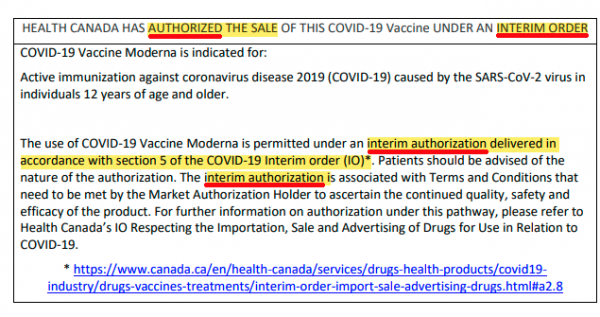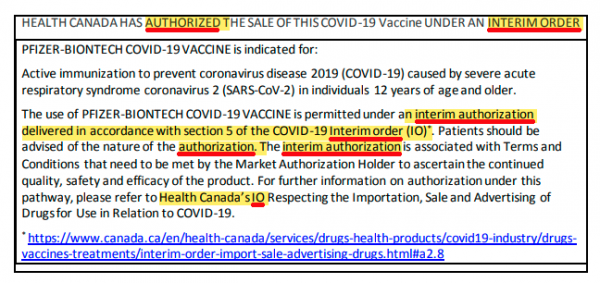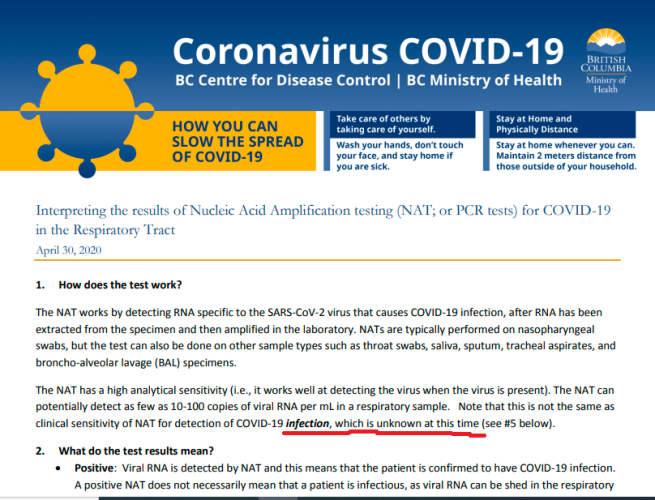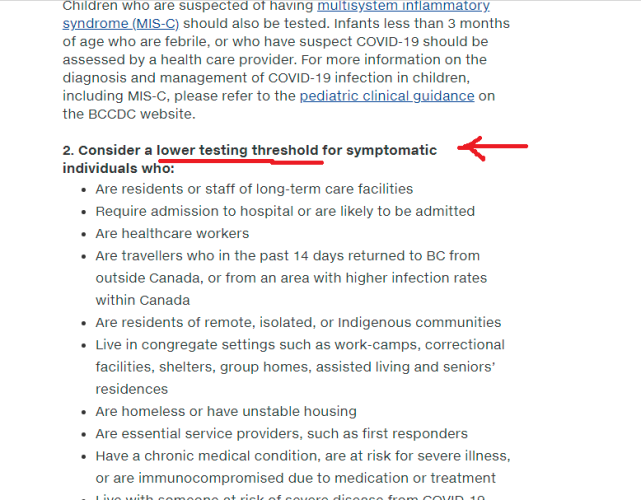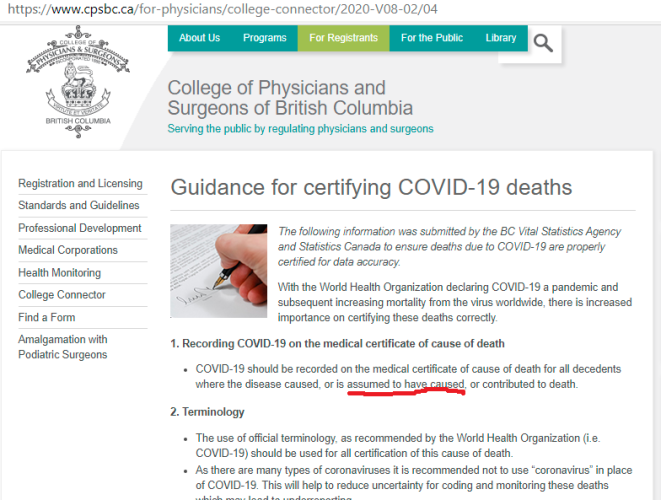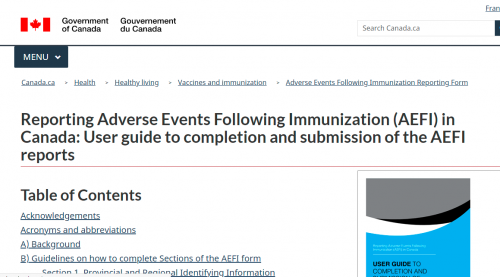
In order for the true effects of a vaccine (or any pharmaceutical) to be fully known, it’s important to have all of the side effects documented and compiled. This is so members of the public can give informed consent, or refuse a product if they see it as unsafe. However, we are getting everything but the truth here.
Normally, clear thinking people would be able to see through such nonsense. However, politicians and hack “journalists” do what they can to keep the public uninformed. A quick example:


In order to keep this “pandemic” psy-op going, it’s necessary that the people in charge engage in mental gymnastics. In particular, the dangers must be exaggerated, and the dangers of the agenda minimized. Never mind that Alberta had zero flu deaths, as the variants are overrunning the Province.
This is done with the gene replacement therapies as well. They are not really “vaccines” as. Now, we can’t have the true scale of problems coming out. Broadly speaking, this is concealed in 2 ways:
- Intentionally inflating Covid-19 deaths
- Deliberate lowballing Of vaccine effects
Both points will be addressed below.
1. Intentionally Inflating Covid-19 Deaths
There is really no way to deny at this point that public officials are flat out lying about virus deaths, and artificially driving up the counts in order to keep the psy-op going. Check out this article for many more examples of this happening. Never mind that the virus has never been isolated, and that the PCR tests are completely useless for this job.
Skeptics may reasonably ask where the emergency if these death waves aren’t materializing. Better to gaslight such people as crazies and not answer. And never mind the fact that the flu and influenza seem to have coincidently disappeared.
2. DEFINITION FOR DEATHS DUE TO COVID-19
.
A death due to COVID-19 is defined for surveillance purposes as a death resulting from a clinically compatible illness, in a probable or confirmed COVID-19 case, unless there is a clear alternative cause of death that cannot be related to COVID disease (e.g. trauma). There should be no period of complete recovery from COVID-19 between illness and death.
.
A death due to COVID-19 may not be attributed to another disease (e.g. cancer) and should be counted independently of preexisting conditions that are suspected of triggering a severe course of COVID-19.
In fairness, this can’t entirely be blamed on politicians like Doug Ford, Christine Elliott, Jason Kenney, John Horgan, or Patty Hajdu. The guidelines are written up in such a way (intentionally?) that it positively invites death count inflation
2. Deliberate Lowballing Of Vaccine Effects
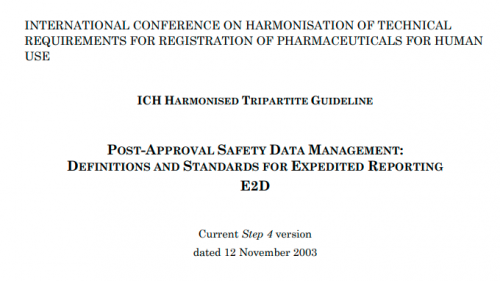
In November 2003, there was the International Conference on Harmonization of Technical Requirements for Registration of Pharamaceuticals for Human Use. Their report is publicly available. Now there are some worthwhile parts in this. One of them is the attempt to create universal standards for reporting side effects of medications.
So, what exactly is worth reporting during drug trials, or once its already on the market?
4. STANDARDS FOR EXPEDITED REPORTING
4.1 What Should Be Reported?
4.1.1 Serious ADRs
Cases of adverse drug reactions that are both serious and unexpected are subject to expedited reporting. The reporting of serious expected reactions in an expedited manner varies among countries. Non-serious adverse reactions, whether expected or not, would normally not be subject to expedited reporting. For reports from studies and other solicited sources, all cases judged by either the reporting healthcare professional or the MAH as having a possible causal relationship to the medicinal product would qualify as ADRs. For purposes of reporting, spontaneous reports associated with approved drugs imply a suspected causal relationship.
4.1.2 Other Observations
In addition to single case reports, any safety information from other observations that could change the risk-benefit evaluation for the product should be communicated as soon as possible to the regulatory authorities in accordance with local regulation. Examples include any significant unanticipated safety findings from an in vitro, animal, epidemiological, or clinical study that suggest a significant human risk, such as evidence of mutagenicity, teratogenicity, carcinogenicity, or lack of efficacy with a drug used in treating a life-threatening or serious disease.
4.1.2.1 Lack of Efficacy
Evidence of lack of efficacy should not normally be expedited, but should be discussed in the relevant periodic safety update report. However, in certain circumstances and in some regions, individual reports of lack of efficacy are considered subject to expedited reporting. Medicinal products used for the treatment of life-threatening or serious diseases, vaccines, and contraceptives are examples of classes of medicinal products where lack of efficacy should be considered for expedited reporting. Clinical judgment should be used in reporting, with consideration of the local product labeling and disease being treated.
Apparently if reactions are serious and unexpected (not just serious), then it’s grounds for reporting in an expedited fashion. Otherwise, then there’s no rush.
It’s also interesting that it says “clinical judgement should be used” in reporting. Are these health care providers to act as a form of gatekeeper to this information getting out? And what is the standard for how that judgement should applied?
The Canadian standard for reporting isn’t much (if any) better.
Should all AEFIs be reported?
No. During their development, vaccines undergo rigorous testing for safety, quality, and efficacy. During these “pre-licensure trials” efforts are made to capture every single adverse event that follows immunization.
By the time a vaccine is authorized for marketing, the safety profile for common adverse events such as vaccination site reactions or mild fever is well known. It is always important to counsel vaccinees or their guardians regarding the possible occurrence of such reactions, but there is no need to report such expected events unless they are more severe or more frequent than expected.
Does this seem bizarre? A drug manufacturer claims that they intend to document and compile all of the data for side effects during clinical trials, but it’s not a big deal once the product is on the market?!
In fairness, the page does immediately contradict itself right after afterwards and say that events should be reported if it can’t be explained otherwise.
The Canadian Government’s own guidelines state that not all AEFI, or adverse effects following immunization, should be reported. The stated reasoning is that (presumably) minor reactions are already to be expected. In other words, these kinds of reactions are EXPECTED to happen, and shouldn’t be reported if minor.
The first problem is that this standard is incredibly subjective, and prone to both human error. Second, the people involved may not want the full truth about the side effects of their products to get out.
The page goes on to say that the preferred way of reporting is to Municipal or Provincial Health Units. The results are then forwarded along. Now, that can create a problem, if the people involved simply don’t view such reactions are worthwhile, or are instructed not to.
According to Public Health Ontario [Page 9] “all deaths temporally associated with receipt of vaccines that have been reported to public health units are thoroughly investigated and reported to PHO.” That’s interesting, since the Ontario Government doesn’t take issue with classifying Covid deaths simply from having the virus. See Christine Elliott above. Remember, WHO’s definition is death from a clinically compatible illness in a probable or confirmed case.
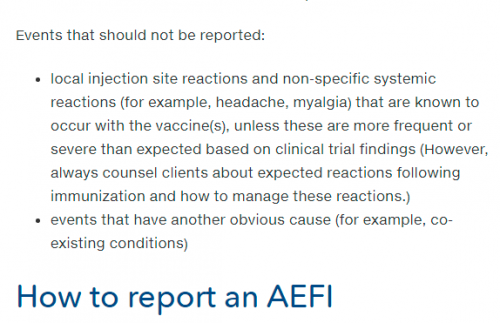
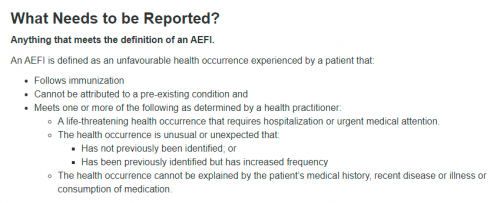
The BC Centre for Disease Control advises not to report on side effects if they are “known to occur” from the vaccine. With this standard in mind, how many legitimate complaints would have been turned away, since these were expected? Alberta also allows for “expected” reactions to bypassed being classified as AEFI.
The obvious questions to ask here: how accurate are the various reporting systems in Canada, and elsewhere? If patients are told not to report certain expected side effects, do we really know the true prevalence? If there is discretion by District Health Units on what to report, how wisely is it being used? How honest are the people who end up using the information at the end anyway?
Very common: may affect more than 1 in 10 people
injection site pain
tiredness
headache
muscle pain
chills
joint pain
fever
diarrhea
Common: may affect more than 1 in 100 and up to 1 in 10 people
injection site redness
injection site swelling
nausea
vomiting
Uncommon: may affect up to 1 in 100 people
enlarged lymph nodes
feeling unwell
arm pain
Non-severe allergic reactions (such as rash, itching, hives or swelling of the face) and severe allergic reactions have been reported.
These are not all the possible side effects you may have when taking Pfizer-BioNTech COVID-19 Vaccine. If you experience any side effects not listed here, tell your healthcare professional.
There is a remote chance that Pfizer-BioNTech COVID-19 Vaccine could cause a severe allergic
reaction. A severe allergic reaction would usually occur within a few minutes to one hour after
getting a dose of Pfizer-BioNTech COVID-19 Vaccine. For this reason, your vaccination provider
may ask you to stay at the place where you received your vaccine for monitoring after
vaccination. Should you develop any serious symptoms or symptoms that could be an allergic
reaction, seek medical attention right away. Symptoms of an allergic reaction include:
hives (bumps on the skin that are often very itchy)
swelling of the face, tongue or throat
difficulty breathing
a fast heartbeat
dizziness and weakness
For reference, the above list is what is or can be “expected” from the Pfizer vaccine. Once more, this mRNA “vaccine” is not approved by Health Canada, and only has interim authorization. Still feeling like a champ?
And all of this, for a virus that’s never been proven to exist, using testing methods never designed for infection detection.
As a final thought, just remember the people manufacturing these concoctions are indemnified from legal liability. It you are injured or killed, it’s your problem.
(1) https://globalnews.ca/news/7460952/alberta-influenza-zero-cases-hospitalizations/
(2) https://www.cbc.ca/news/canada/edmonton/alberta-third-wave-pandemic-variants-1.5972869
(3) https://www.who.int/classifications/icd/Guidelines_Cause_of_Death_COVID-19.pdf?ua=1
(4) https://database.ich.org/sites/default/files/E2A_Guideline.pdf
(5) Adverse Effect Reporting Guidelines World Health Org
(6) https://vaccine-safety-training.org/tl_files/vs/pdf/report-of-cioms-who-working-group.pdf
(7) WHO Vaccine Safety Training Manual
(8) https://www.publichealthontario.ca/-/media/documents/ncov/epi/covid-19-aefi-report.pdf?la=en
(9) Adverse Effect Reporting Guidelines Ontario
(10) https://www.health.gov.on.ca/en/pro/programs/publichealth/oph_standards/docs/aefi_cd.pdf
(11) Adverse Effects Case Definitions Ontario
(12) https://www.publichealthontario.ca/-/media/documents/ncov/epi/covid-19-aefi-report.pdf?la=en
(13) http://www.bccdc.ca/health-professionals/clinical-resources/adverse-events-following-immunization
(14) https://www.albertahealthservices.ca/info/Page16187.aspx
(15) Health Canada Reporting Adverse Reactions
(16) https://archive.is/Uz0hx
(17) https://www.canada.ca/en/public-health/services/immunization/reporting-adverse-events-following-immunization/user-guide-completion-submission-aefi-reports.html
(18) Health Canada On Vaccine Safety
(19) https://www.canada.ca/en/public-health/services/reports-publications/canada-communicable-disease-report-ccdr/monthly-issue/2014-40/ccdr-volume-40-s-3-december-4-2014/ccdr-volume-40-s-3-december-4-2014-2.html
(20) https://www.canada.ca/content/dam/phac-aspc/migration/phac-aspc/publicat/ccdr-rmtc/14vol40/dr-rm40s-3/assets/pdf/ccdrv40is3a05-eng.pdf
(21) Vaccine Vigilance Working Group Report
(22) https://canucklaw.ca/cv-26c-exposing-the-lies-of-the-inflated-death-tolls/
(23) https://canucklaw.ca/cv-37h-bccdc-admitted-a-year-ago-pcr-tests-dont-work-as-advertised/
(24) https://canucklaw.ca/wp-content/uploads/2020/11/FOI-Fluroide-Free-Peel-Compilation.pdf
Like this:
Like Loading...
